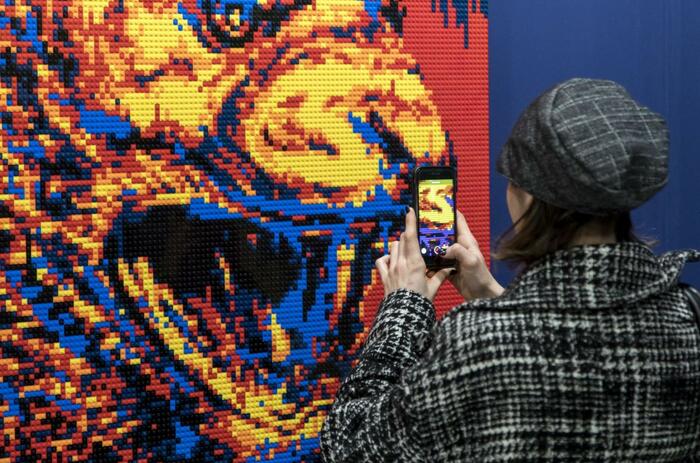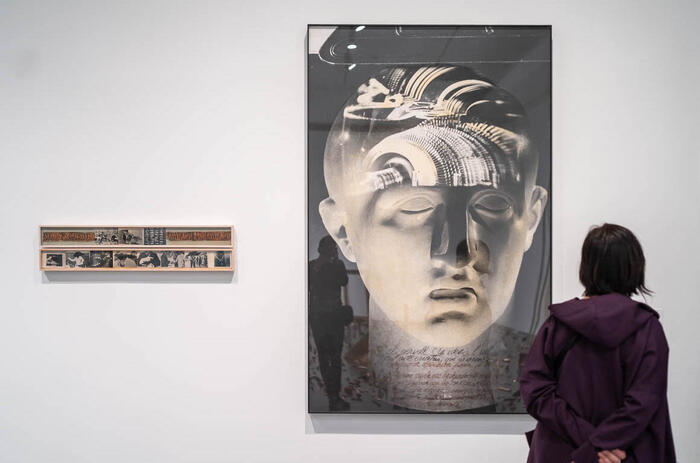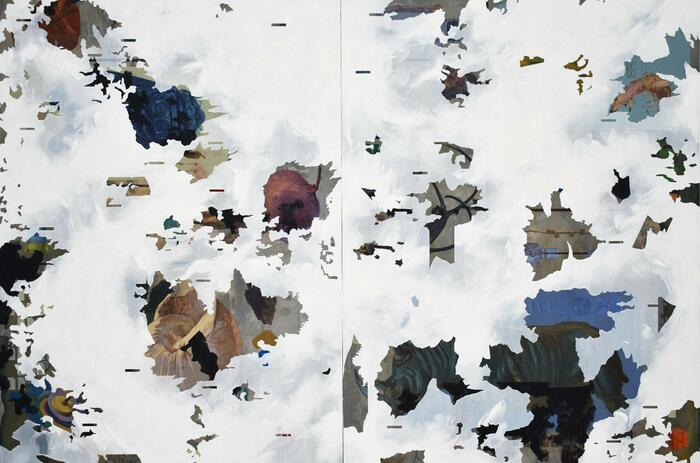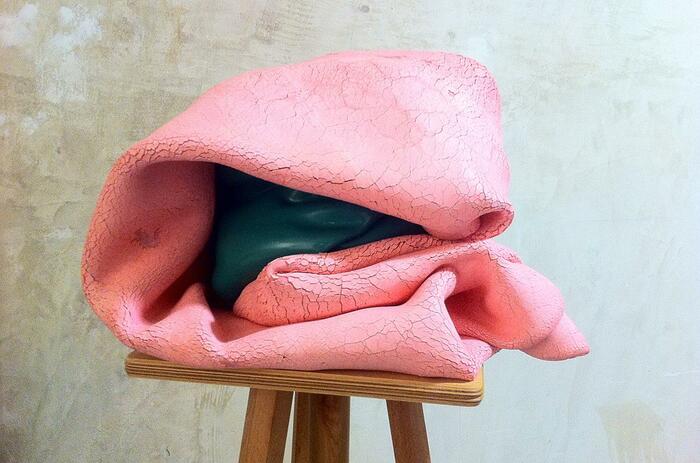THE BOTÍN CENTER EXHIBITS PICASSO IBERO AND TRACES THE ARTIST’S TIES TO “PRIMITIVE” ART
The exhibition aims to explore the influence of Iberian art in Pablo Picasso’s oeuvre through more tan 200 pieces. Organised with the Musée national Picasso-Paris and curated by Cécile Godefroy and Roberto Ontañón Peredo, this stimulating, original exhibition invites visitors to reflect on how the discovery of a native, “primitive”, art shaped the artistic language and identity of one of the greatest artists in the twentieth century.

Pablo Picasso (1881-1973) came into contact with Iberian art in 1906, in the gallery of the Near Eastern Antiquities of the Louvre Museum, where he saw the Cerro de los Santos sculptures (Albacete) and the Lady of Elche, among others. Over the following months, he made a number of works, including sketches, sculptures and paintings, inspired by these monumental stone statues and bronze votive offerings. It was a turning point in his formal enquiries, leading him away from classical representation and paving the way for Cubism.
PICASSO IBERO shows about 100 works spanning Picasso’s career from the days of Proto-Cubism to his final years, while examining his fruitful dialogue with the past, from the developments that led the artist from Rose Period to the works produced in 1908, to the works showing formal or conceptual echoes of Iberian themes, practices or characteristics, introducing his final years and displaying a wide range of techniques and gestures.
-
Pablo Picasso. Femme aux mains jointes (étude pour “Les Demoiselles d’Avignon”), 1907. © Succession Picasso. VEGAP, Madrid, 2021. Photo: ©RMN-Grand Palais (Musée national Picasso-Paris) – ©Mathieu Rabeau // Cabeza masculina. Museo Arqueológico Nacional. Inv.7505. Foto: Ángel Martínez Levas
-
Pablo Picasso. Femme aux mains jointes (étude pour “Les Demoiselles d’Avignon”), 1907. © Succession Picasso. VEGAP, Madrid, 2021. Photo: ©RMN-Grand Palais (Musée national Picasso-Paris) – ©Mathieu Rabeau // Cabeza masculina. Museo Arqueológico Nacional. Inv.7505. Foto: Ángel Martínez Levas
-
Vista de exposición. Cortesía del Centro Botín.
-
Autoportrait, 1906 - Picasso Pablo (dit), Ruiz Picasso Pablo (1881-1973) © Sucesión Pablo Picasso. VEGAP, Madrid, 2020. Foto: © RMN-Grand Palais (Musée national Picasso-Paris) / Mathieu Rabeau
-
Pablo Picasso. Tête masculine © RMN-Grand Palais (musée du Louvre) / Daniel Arnaudet
-
Pablo Picasso - Deux femmes nues - Paris, 1906 - Fusain sur papier - 63,5 x 48 cm - Fundación Almine y Bernard Ruiz-Picasso para el Arte, Madrid © FABA Photo : Marc Domage
-
Archivo Fotográfico Museo Nacional Centro de Arte Reina Sofía - Junto a la reproducción de la imagen: “Museo Nacional Centro de Arte Reina Sofía” - Autor: Pablo RUIZ PICASSO - Título: “La femme au vase», 1933
-
Le Baiser, 1929 - Réalisé à Dinard - MP117 - Picasso Pablo (dit), Ruiz Picasso Pablo (1881-1973) © Sucesión Pablo Picasso. VEGAP, Madrid, 2020. Foto : © RMN-Grand Palais (Musée national Picasso-Paris) / Mathieu Rabeau
-
Relieve. Museo Arqueológico Nacional. Inv. 38429. Foto: Ángel Martínez Levas
This is the first time that this number of archaeological pieces have been gathered for an exhibition, illustrating the diversity of Iberian art by comprising large-scale stone sculptures, bronze artifacts and painted ceramics.
May interest you

The fair will take place from July 7 to 11 with a special highlight on new protagonists. In addition to the General Program and the Opening Program, ARCO incorporates REMITENTE, a special Latin American art section and concentrates Artist Projects exclusively on women. In total, the fair will host 131 galleries, of which 54% are not Spanish.
ARCOmadrid - NEW FOCUS ON LATIN AMERICAN GALLERIES AND FEMALE ARTISTS
The fair will take place from July 7 to 11 with a special highlight on new protagonists. In addition to the General Program and the Opening Program, ARCO incorporates REMITENTE, a special Latin American art section and concentrates Artist Projects exclusively on women. In total, the fair will host 131 galleries, of which 54% are not Spanish.

The fair will take place from July 7 to 11 with a special highlight on new protagonists. In addition to the General Program and the Opening Program, ARCO incorporates REMITENTE, a special Latin American art section and concentrates Artist Projects exclusively on women. In total, the fair will host 131 galleries, of which 54% are not Spanish.
ARCOmadrid - NEW FOCUS ON LATIN AMERICAN GALLERIES AND FEMALE ARTISTS
The fair will take place from July 7 to 11 with a special highlight on new protagonists. In addition to the General Program and the Opening Program, ARCO incorporates REMITENTE, a special Latin American art section and concentrates Artist Projects exclusively on women. In total, the fair will host 131 galleries, of which 54% are not Spanish.

The Rafael Tous Collection, donated to MACBA (Museu d'Art Contemporani de Barcelona) just one year ago, is the portrait of a moment and specific artistic practices. A passionate collector linked to the textile world, Rafael Tous opted for conceptual art as a set of plural practices that prioritized the idea and the process over the object. Without speculative intention and in an intuitive way, Tous set up a collection that brings together the attitudes and experimental works of a group of artists with whom, in many cases, he established bonds of friendship, in addition to accompanying them in their artistic growth. Exhibition curated by: Antònia Maria Perelló, curator and head of the MACBA Collection, and Claudia Segura, curator of exhibitions and Collection.
IN REAL TIME. THE RAFAEL TOUS COLLECTION OF CONCEPTUAL ART
The Rafael Tous Collection, donated to MACBA (Museu d'Art Contemporani de Barcelona) just one year ago, is the portrait of a moment and specific artistic practices. A passionate collector linked to the textile world, Rafael Tous opted for conceptual art as a set of plural practices that prioritized the idea and the process over the object. Without speculative intention and in an intuitive way, Tous set up a collection that brings together the attitudes and experimental works of a group of artists with whom, in many cases, he established bonds of friendship, in addition to accompanying them in their artistic growth. Exhibition curated by: Antònia Maria Perelló, curator and head of the MACBA Collection, and Claudia Segura, curator of exhibitions and Collection.

Exhibited at Galería Zielinsky, this solo exhibition will take place until September 10, 2021 in Barcelona. It gives an account of the recent production of the artist, who bases his research on envisioning a new perspective of the landscape: extracting the layers of the environment he inhabits and discovering the synergies that arise between fragments of everyday ruins with materials of great symbolic charge.
DANIEL ORTEGA CREATES AN IMAGINARY OF FUTURE ARCHEOLOGY IN HIS EXHIBITION "ABRAXAS"
Exhibited at Galería Zielinsky, this solo exhibition will take place until September 10, 2021 in Barcelona. It gives an account of the recent production of the artist, who bases his research on envisioning a new perspective of the landscape: extracting the layers of the environment he inhabits and discovering the synergies that arise between fragments of everyday ruins with materials of great symbolic charge.

Conceived as an exhibition project in progress, with an essential educational aspect, the exhibition A recent art history (1960-2020), brings together two complementary and consecutive art collections - that of the Juan March Foundation and that of DKV Seguros - in the two museums of the Juan March Foundation, the Cuenca Museum of Abstract Art and the Juan March Foundation Museum in Palma.
A HISTORY OF RECENT ART (1960-2020) - DKV COLLECTION AND JUAN MARCH FOUNDATION
Conceived as an exhibition project in progress, with an essential educational aspect, the exhibition A recent art history (1960-2020), brings together two complementary and consecutive art collections - that of the Juan March Foundation and that of DKV Seguros - in the two museums of the Juan March Foundation, the Cuenca Museum of Abstract Art and the Juan March Foundation Museum in Palma.

The Plastic Arts Grants are intended both for the training and development of personal and research projects, linked to artistic creation and not theoretical study. Artists of any nationality can apply to this call in order to move abroad and continue their work, study or stay in residence. Application deadline: September 3rd, 2021.
BOTÍN FOUNDATION’S PLASTIC ARTS GRANTS
The Plastic Arts Grants are intended both for the training and development of personal and research projects, linked to artistic creation and not theoretical study. Artists of any nationality can apply to this call in order to move abroad and continue their work, study or stay in residence. Application deadline: September 3rd, 2021.

The fair will take place from July 7 to 11 with a special highlight on new protagonists. In addition to the General Program and the Opening Program, ARCO incorporates REMITENTE, a special Latin American art section and concentrates Artist Projects exclusively on women. In total, the fair will host 131 galleries, of which 54% are not Spanish.
ARCOmadrid - NEW FOCUS ON LATIN AMERICAN GALLERIES AND FEMALE ARTISTS
The fair will take place from July 7 to 11 with a special highlight on new protagonists. In addition to the General Program and the Opening Program, ARCO incorporates REMITENTE, a special Latin American art section and concentrates Artist Projects exclusively on women. In total, the fair will host 131 galleries, of which 54% are not Spanish.

The Rafael Tous Collection, donated to MACBA (Museu d'Art Contemporani de Barcelona) just one year ago, is the portrait of a moment and specific artistic practices. A passionate collector linked to the textile world, Rafael Tous opted for conceptual art as a set of plural practices that prioritized the idea and the process over the object. Without speculative intention and in an intuitive way, Tous set up a collection that brings together the attitudes and experimental works of a group of artists with whom, in many cases, he established bonds of friendship, in addition to accompanying them in their artistic growth. Exhibition curated by: Antònia Maria Perelló, curator and head of the MACBA Collection, and Claudia Segura, curator of exhibitions and Collection.
IN REAL TIME. THE RAFAEL TOUS COLLECTION OF CONCEPTUAL ART
The Rafael Tous Collection, donated to MACBA (Museu d'Art Contemporani de Barcelona) just one year ago, is the portrait of a moment and specific artistic practices. A passionate collector linked to the textile world, Rafael Tous opted for conceptual art as a set of plural practices that prioritized the idea and the process over the object. Without speculative intention and in an intuitive way, Tous set up a collection that brings together the attitudes and experimental works of a group of artists with whom, in many cases, he established bonds of friendship, in addition to accompanying them in their artistic growth. Exhibition curated by: Antònia Maria Perelló, curator and head of the MACBA Collection, and Claudia Segura, curator of exhibitions and Collection.

Exhibited at Galería Zielinsky, this solo exhibition will take place until September 10, 2021 in Barcelona. It gives an account of the recent production of the artist, who bases his research on envisioning a new perspective of the landscape: extracting the layers of the environment he inhabits and discovering the synergies that arise between fragments of everyday ruins with materials of great symbolic charge.
DANIEL ORTEGA CREATES AN IMAGINARY OF FUTURE ARCHEOLOGY IN HIS EXHIBITION "ABRAXAS"
Exhibited at Galería Zielinsky, this solo exhibition will take place until September 10, 2021 in Barcelona. It gives an account of the recent production of the artist, who bases his research on envisioning a new perspective of the landscape: extracting the layers of the environment he inhabits and discovering the synergies that arise between fragments of everyday ruins with materials of great symbolic charge.

Conceived as an exhibition project in progress, with an essential educational aspect, the exhibition A recent art history (1960-2020), brings together two complementary and consecutive art collections - that of the Juan March Foundation and that of DKV Seguros - in the two museums of the Juan March Foundation, the Cuenca Museum of Abstract Art and the Juan March Foundation Museum in Palma.
A HISTORY OF RECENT ART (1960-2020) - DKV COLLECTION AND JUAN MARCH FOUNDATION
Conceived as an exhibition project in progress, with an essential educational aspect, the exhibition A recent art history (1960-2020), brings together two complementary and consecutive art collections - that of the Juan March Foundation and that of DKV Seguros - in the two museums of the Juan March Foundation, the Cuenca Museum of Abstract Art and the Juan March Foundation Museum in Palma.

The Plastic Arts Grants are intended both for the training and development of personal and research projects, linked to artistic creation and not theoretical study. Artists of any nationality can apply to this call in order to move abroad and continue their work, study or stay in residence. Application deadline: September 3rd, 2021.
BOTÍN FOUNDATION’S PLASTIC ARTS GRANTS
The Plastic Arts Grants are intended both for the training and development of personal and research projects, linked to artistic creation and not theoretical study. Artists of any nationality can apply to this call in order to move abroad and continue their work, study or stay in residence. Application deadline: September 3rd, 2021.

The fair will take place from July 7 to 11 with a special highlight on new protagonists. In addition to the General Program and the Opening Program, ARCO incorporates REMITENTE, a special Latin American art section and concentrates Artist Projects exclusively on women. In total, the fair will host 131 galleries, of which 54% are not Spanish.
ARCOmadrid - NEW FOCUS ON LATIN AMERICAN GALLERIES AND FEMALE ARTISTS
The fair will take place from July 7 to 11 with a special highlight on new protagonists. In addition to the General Program and the Opening Program, ARCO incorporates REMITENTE, a special Latin American art section and concentrates Artist Projects exclusively on women. In total, the fair will host 131 galleries, of which 54% are not Spanish.

The Rafael Tous Collection, donated to MACBA (Museu d'Art Contemporani de Barcelona) just one year ago, is the portrait of a moment and specific artistic practices. A passionate collector linked to the textile world, Rafael Tous opted for conceptual art as a set of plural practices that prioritized the idea and the process over the object. Without speculative intention and in an intuitive way, Tous set up a collection that brings together the attitudes and experimental works of a group of artists with whom, in many cases, he established bonds of friendship, in addition to accompanying them in their artistic growth. Exhibition curated by: Antònia Maria Perelló, curator and head of the MACBA Collection, and Claudia Segura, curator of exhibitions and Collection.
IN REAL TIME. THE RAFAEL TOUS COLLECTION OF CONCEPTUAL ART
The Rafael Tous Collection, donated to MACBA (Museu d'Art Contemporani de Barcelona) just one year ago, is the portrait of a moment and specific artistic practices. A passionate collector linked to the textile world, Rafael Tous opted for conceptual art as a set of plural practices that prioritized the idea and the process over the object. Without speculative intention and in an intuitive way, Tous set up a collection that brings together the attitudes and experimental works of a group of artists with whom, in many cases, he established bonds of friendship, in addition to accompanying them in their artistic growth. Exhibition curated by: Antònia Maria Perelló, curator and head of the MACBA Collection, and Claudia Segura, curator of exhibitions and Collection.

Exhibited at Galería Zielinsky, this solo exhibition will take place until September 10, 2021 in Barcelona. It gives an account of the recent production of the artist, who bases his research on envisioning a new perspective of the landscape: extracting the layers of the environment he inhabits and discovering the synergies that arise between fragments of everyday ruins with materials of great symbolic charge.
DANIEL ORTEGA CREATES AN IMAGINARY OF FUTURE ARCHEOLOGY IN HIS EXHIBITION "ABRAXAS"
Exhibited at Galería Zielinsky, this solo exhibition will take place until September 10, 2021 in Barcelona. It gives an account of the recent production of the artist, who bases his research on envisioning a new perspective of the landscape: extracting the layers of the environment he inhabits and discovering the synergies that arise between fragments of everyday ruins with materials of great symbolic charge.

Conceived as an exhibition project in progress, with an essential educational aspect, the exhibition A recent art history (1960-2020), brings together two complementary and consecutive art collections - that of the Juan March Foundation and that of DKV Seguros - in the two museums of the Juan March Foundation, the Cuenca Museum of Abstract Art and the Juan March Foundation Museum in Palma.
A HISTORY OF RECENT ART (1960-2020) - DKV COLLECTION AND JUAN MARCH FOUNDATION
Conceived as an exhibition project in progress, with an essential educational aspect, the exhibition A recent art history (1960-2020), brings together two complementary and consecutive art collections - that of the Juan March Foundation and that of DKV Seguros - in the two museums of the Juan March Foundation, the Cuenca Museum of Abstract Art and the Juan March Foundation Museum in Palma.

The Plastic Arts Grants are intended both for the training and development of personal and research projects, linked to artistic creation and not theoretical study. Artists of any nationality can apply to this call in order to move abroad and continue their work, study or stay in residence. Application deadline: September 3rd, 2021.
BOTÍN FOUNDATION’S PLASTIC ARTS GRANTS
The Plastic Arts Grants are intended both for the training and development of personal and research projects, linked to artistic creation and not theoretical study. Artists of any nationality can apply to this call in order to move abroad and continue their work, study or stay in residence. Application deadline: September 3rd, 2021.

The fair will take place from July 7 to 11 with a special highlight on new protagonists. In addition to the General Program and the Opening Program, ARCO incorporates REMITENTE, a special Latin American art section and concentrates Artist Projects exclusively on women. In total, the fair will host 131 galleries, of which 54% are not Spanish.
ARCOmadrid - NEW FOCUS ON LATIN AMERICAN GALLERIES AND FEMALE ARTISTS
The fair will take place from July 7 to 11 with a special highlight on new protagonists. In addition to the General Program and the Opening Program, ARCO incorporates REMITENTE, a special Latin American art section and concentrates Artist Projects exclusively on women. In total, the fair will host 131 galleries, of which 54% are not Spanish.

The Rafael Tous Collection, donated to MACBA (Museu d'Art Contemporani de Barcelona) just one year ago, is the portrait of a moment and specific artistic practices. A passionate collector linked to the textile world, Rafael Tous opted for conceptual art as a set of plural practices that prioritized the idea and the process over the object. Without speculative intention and in an intuitive way, Tous set up a collection that brings together the attitudes and experimental works of a group of artists with whom, in many cases, he established bonds of friendship, in addition to accompanying them in their artistic growth. Exhibition curated by: Antònia Maria Perelló, curator and head of the MACBA Collection, and Claudia Segura, curator of exhibitions and Collection.
IN REAL TIME. THE RAFAEL TOUS COLLECTION OF CONCEPTUAL ART
The Rafael Tous Collection, donated to MACBA (Museu d'Art Contemporani de Barcelona) just one year ago, is the portrait of a moment and specific artistic practices. A passionate collector linked to the textile world, Rafael Tous opted for conceptual art as a set of plural practices that prioritized the idea and the process over the object. Without speculative intention and in an intuitive way, Tous set up a collection that brings together the attitudes and experimental works of a group of artists with whom, in many cases, he established bonds of friendship, in addition to accompanying them in their artistic growth. Exhibition curated by: Antònia Maria Perelló, curator and head of the MACBA Collection, and Claudia Segura, curator of exhibitions and Collection.

Exhibited at Galería Zielinsky, this solo exhibition will take place until September 10, 2021 in Barcelona. It gives an account of the recent production of the artist, who bases his research on envisioning a new perspective of the landscape: extracting the layers of the environment he inhabits and discovering the synergies that arise between fragments of everyday ruins with materials of great symbolic charge.
DANIEL ORTEGA CREATES AN IMAGINARY OF FUTURE ARCHEOLOGY IN HIS EXHIBITION "ABRAXAS"
Exhibited at Galería Zielinsky, this solo exhibition will take place until September 10, 2021 in Barcelona. It gives an account of the recent production of the artist, who bases his research on envisioning a new perspective of the landscape: extracting the layers of the environment he inhabits and discovering the synergies that arise between fragments of everyday ruins with materials of great symbolic charge.

Conceived as an exhibition project in progress, with an essential educational aspect, the exhibition A recent art history (1960-2020), brings together two complementary and consecutive art collections - that of the Juan March Foundation and that of DKV Seguros - in the two museums of the Juan March Foundation, the Cuenca Museum of Abstract Art and the Juan March Foundation Museum in Palma.
A HISTORY OF RECENT ART (1960-2020) - DKV COLLECTION AND JUAN MARCH FOUNDATION
Conceived as an exhibition project in progress, with an essential educational aspect, the exhibition A recent art history (1960-2020), brings together two complementary and consecutive art collections - that of the Juan March Foundation and that of DKV Seguros - in the two museums of the Juan March Foundation, the Cuenca Museum of Abstract Art and the Juan March Foundation Museum in Palma.

The Plastic Arts Grants are intended both for the training and development of personal and research projects, linked to artistic creation and not theoretical study. Artists of any nationality can apply to this call in order to move abroad and continue their work, study or stay in residence. Application deadline: September 3rd, 2021.
BOTÍN FOUNDATION’S PLASTIC ARTS GRANTS
The Plastic Arts Grants are intended both for the training and development of personal and research projects, linked to artistic creation and not theoretical study. Artists of any nationality can apply to this call in order to move abroad and continue their work, study or stay in residence. Application deadline: September 3rd, 2021.

The fair will take place from July 7 to 11 with a special highlight on new protagonists. In addition to the General Program and the Opening Program, ARCO incorporates REMITENTE, a special Latin American art section and concentrates Artist Projects exclusively on women. In total, the fair will host 131 galleries, of which 54% are not Spanish.
ARCOmadrid - NEW FOCUS ON LATIN AMERICAN GALLERIES AND FEMALE ARTISTS
The fair will take place from July 7 to 11 with a special highlight on new protagonists. In addition to the General Program and the Opening Program, ARCO incorporates REMITENTE, a special Latin American art section and concentrates Artist Projects exclusively on women. In total, the fair will host 131 galleries, of which 54% are not Spanish.

The Rafael Tous Collection, donated to MACBA (Museu d'Art Contemporani de Barcelona) just one year ago, is the portrait of a moment and specific artistic practices. A passionate collector linked to the textile world, Rafael Tous opted for conceptual art as a set of plural practices that prioritized the idea and the process over the object. Without speculative intention and in an intuitive way, Tous set up a collection that brings together the attitudes and experimental works of a group of artists with whom, in many cases, he established bonds of friendship, in addition to accompanying them in their artistic growth. Exhibition curated by: Antònia Maria Perelló, curator and head of the MACBA Collection, and Claudia Segura, curator of exhibitions and Collection.
IN REAL TIME. THE RAFAEL TOUS COLLECTION OF CONCEPTUAL ART
The Rafael Tous Collection, donated to MACBA (Museu d'Art Contemporani de Barcelona) just one year ago, is the portrait of a moment and specific artistic practices. A passionate collector linked to the textile world, Rafael Tous opted for conceptual art as a set of plural practices that prioritized the idea and the process over the object. Without speculative intention and in an intuitive way, Tous set up a collection that brings together the attitudes and experimental works of a group of artists with whom, in many cases, he established bonds of friendship, in addition to accompanying them in their artistic growth. Exhibition curated by: Antònia Maria Perelló, curator and head of the MACBA Collection, and Claudia Segura, curator of exhibitions and Collection.

Exhibited at Galería Zielinsky, this solo exhibition will take place until September 10, 2021 in Barcelona. It gives an account of the recent production of the artist, who bases his research on envisioning a new perspective of the landscape: extracting the layers of the environment he inhabits and discovering the synergies that arise between fragments of everyday ruins with materials of great symbolic charge.
DANIEL ORTEGA CREATES AN IMAGINARY OF FUTURE ARCHEOLOGY IN HIS EXHIBITION "ABRAXAS"
Exhibited at Galería Zielinsky, this solo exhibition will take place until September 10, 2021 in Barcelona. It gives an account of the recent production of the artist, who bases his research on envisioning a new perspective of the landscape: extracting the layers of the environment he inhabits and discovering the synergies that arise between fragments of everyday ruins with materials of great symbolic charge.

Conceived as an exhibition project in progress, with an essential educational aspect, the exhibition A recent art history (1960-2020), brings together two complementary and consecutive art collections - that of the Juan March Foundation and that of DKV Seguros - in the two museums of the Juan March Foundation, the Cuenca Museum of Abstract Art and the Juan March Foundation Museum in Palma.
A HISTORY OF RECENT ART (1960-2020) - DKV COLLECTION AND JUAN MARCH FOUNDATION
Conceived as an exhibition project in progress, with an essential educational aspect, the exhibition A recent art history (1960-2020), brings together two complementary and consecutive art collections - that of the Juan March Foundation and that of DKV Seguros - in the two museums of the Juan March Foundation, the Cuenca Museum of Abstract Art and the Juan March Foundation Museum in Palma.

The Plastic Arts Grants are intended both for the training and development of personal and research projects, linked to artistic creation and not theoretical study. Artists of any nationality can apply to this call in order to move abroad and continue their work, study or stay in residence. Application deadline: September 3rd, 2021.
BOTÍN FOUNDATION’S PLASTIC ARTS GRANTS
The Plastic Arts Grants are intended both for the training and development of personal and research projects, linked to artistic creation and not theoretical study. Artists of any nationality can apply to this call in order to move abroad and continue their work, study or stay in residence. Application deadline: September 3rd, 2021.




